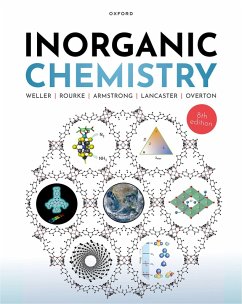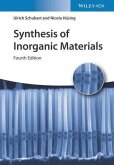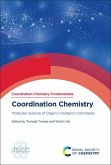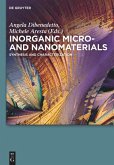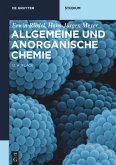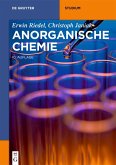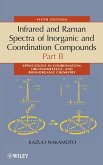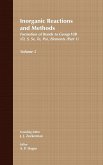- Broschiertes Buch
- Merkliste
- Auf die Merkliste
- Bewerten Bewerten
- Teilen
- Produkt teilen
- Produkterinnerung
- Produkterinnerung
Leading you from the fundamental principles of inorganic chemistry right through to cutting-edge research at the frontiers of the subject, Inorganic Chemistry is the ideal course companion for the duration of your degree.
Andere Kunden interessierten sich auch für
![Synthesis of Inorganic Materials Synthesis of Inorganic Materials]() Ulrich SchubertSynthesis of Inorganic Materials68,99 €
Ulrich SchubertSynthesis of Inorganic Materials68,99 €![Coordination Chemistry Coordination Chemistry]() Coordination Chemistry100,99 €
Coordination Chemistry100,99 €![Inorganic Micro- and Nanomaterials Inorganic Micro- and Nanomaterials]() Inorganic Micro- and Nanomaterials141,99 €
Inorganic Micro- and Nanomaterials141,99 €![Allgemeine und Anorganische Chemie Allgemeine und Anorganische Chemie]() Erwin RiedelAllgemeine und Anorganische Chemie59,95 €
Erwin RiedelAllgemeine und Anorganische Chemie59,95 €![Anorganische Chemie Anorganische Chemie]() Erwin RiedelAnorganische Chemie92,95 €
Erwin RiedelAnorganische Chemie92,95 €![Infrared and Raman Spectra of Inorganic and Coordination Compounds, Part B Infrared and Raman Spectra of Inorganic and Coordination Compounds, Part B]() Kazuo NakamotoInfrared and Raman Spectra of Inorganic and Coordination Compounds, Part B183,99 €
Kazuo NakamotoInfrared and Raman Spectra of Inorganic and Coordination Compounds, Part B183,99 €![Inorganic Reactions and Methods, the Formation of Bonds to Group Vib (O, S, Se, Te, Po) Elements (Part 1) Inorganic Reactions and Methods, the Formation of Bonds to Group Vib (O, S, Se, Te, Po) Elements (Part 1)]() J. J. Zuckerman / A. P. Hagen (Hgg.)Inorganic Reactions and Methods, the Formation of Bonds to Group Vib (O, S, Se, Te, Po) Elements (Part 1)674,99 €
J. J. Zuckerman / A. P. Hagen (Hgg.)Inorganic Reactions and Methods, the Formation of Bonds to Group Vib (O, S, Se, Te, Po) Elements (Part 1)674,99 €-
-
-
Leading you from the fundamental principles of inorganic chemistry right through to cutting-edge research at the frontiers of the subject, Inorganic Chemistry is the ideal course companion for the duration of your degree.
Hinweis: Dieser Artikel kann nur an eine deutsche Lieferadresse ausgeliefert werden.
Hinweis: Dieser Artikel kann nur an eine deutsche Lieferadresse ausgeliefert werden.
Produktdetails
- Produktdetails
- Verlag: Oxford University Press
- 8. Auflage
- Seitenzahl: 1056
- Erscheinungstermin: 21. Februar 2025
- Englisch
- Abmessung: 276mm x 219mm x 41mm
- Gewicht: 2578g
- ISBN-13: 9780198866916
- ISBN-10: 0198866917
- Artikelnr.: 71643165
- Herstellerkennzeichnung
- Libri GmbH
- Europaallee 1
- 36244 Bad Hersfeld
- gpsr@libri.de
- Verlag: Oxford University Press
- 8. Auflage
- Seitenzahl: 1056
- Erscheinungstermin: 21. Februar 2025
- Englisch
- Abmessung: 276mm x 219mm x 41mm
- Gewicht: 2578g
- ISBN-13: 9780198866916
- ISBN-10: 0198866917
- Artikelnr.: 71643165
- Herstellerkennzeichnung
- Libri GmbH
- Europaallee 1
- 36244 Bad Hersfeld
- gpsr@libri.de
Mark Weller is an honorary professor of chemistry at Cardiff University. His research interests cover a wide range of synthetic and structural inorganic chemistry including photovoltaic compounds, zeolites, battery materials, and specialist pigments. Mark has taught both inorganic chemistry and physical chemistry methods at undergraduate and postgraduate levels for over 40 years, with his lectures covering topics across materials chemistry, the inorganic chemistry of the s- and f- block elements, and analytical methods applied to inorganic compounds. He is a co-author of OUP's Characterisation Methods in Inorganic Chemistry and an OUP Primer (23) on Inorganic Materials Chemistry. Jonathan Rourke is Reader in Chemistry at Cardiff University and Honorary Professor of Chemistry at the University of Warwick. He received his PhD at the University of Sheffield on organometallic polymers and liquid crystals, followed by postdoctoral work in Canada and back in Britain. His initial independent research career began at Bristol University and then at Warwick, before he moved to Cardiff. Over the years Dr Rourke has taught most aspects of inorganic chemistry, all the way from basic bonding, through symmetry analysis to advanced transition metal chemistry. Fraser Armstrong is an Emeritus Research Fellow of St John's College, University of Oxford. He was an Associate Professor at the University of California, Irvine, before joining the Department of Chemistry at Oxford in 1993. His interests span the fields of renewable energy, hydrogen, enzymology, mechanistic biological inorganic chemistry, and electrocatalysis by enzymes. He has received numerous awards and honours, including the European Medal for Biological Inorganic Chemistry (1998), the Joseph Chatt Medal (2010), The Davy Medal of the Royal Society (2012), the Bailar Medal of the University of Illinois (2015/16), the Glenn T. Seaborg Lectureship in Inorganic Chemistry, University of California, Berkeley (2021-22), and the Mok Hing-Yiu Distinguished Visiting Professorship in Chemistry at the University of Hong Kong, 2023-25. He was elected as a Fellow of the Royal Society of London (FRS) in 2008. Simon Lancaster has taught Chemistry at the University of East Anglia since his appointment as a lecturer in 2000. He won a National Teaching Fellowship and an RSC Higher Education Teaching Award in 2013 for 'blurring the boundaries between the internet and the lecture theatre'. Simon was promoted to a chair in Chemistry Education in 2014. He was selected as one of RSC's 175 face of diversity in 2016 and championed inclusion and diversity as President of the Education Division Council from 2017-2020. He is a passionate advocate for evidence-based teaching innovation, and is in demand as a speaker and consultant well beyond the chemistry arena. He has shaped UEA's Science teaching provision as Associate Dean for Learning and Teaching since 2022 and has led the adoption of tailored active blended learning approaches and extended reality technologies. He regards the lecture theatre as his laboratory and continues to teach over 100 contact hours a year. Tina Overton was the Director of the Leeds Institute for Teaching Excellence at the University of Leeds, UK.
Part 1: Foundations
1: Atomic structure
2: Molecular structure, bonding, and energetics
3: Molecular symmetry
4: The structures and energetics of simple solids
5: Acids and bases
6: Oxidation and reduction
7: An introduction to coordination compounds
8: Physical techniques in inorganic chemistry
Part 2: The elements and their compounds
9: Periodic trends
10: Themes across the Periodic Table
11: Hydrogen
12: The Group 1 elements
13: The Group 2 elements
14: The Group 13 elements
15: The Group 14 elements
16: The Group 15 elements
17: The Group 16 elements
18: The Group 17 elements
19: The Group 18 elements
20: The d-block elements
21: The f-block elements
22: d- and f-metal complexes: electronic and magnetic properties
23: Coordination chemistry: reactions of complexes
24: d-Metal organometallic chemistry
24: Materials chemistry and nanomaterials
Part Three: Advanced Inorganic Chemistry
25: Advanced solid state chemistry: structures, compounds, and electronic properties
26: Biological inorganic chemistry
Part Four: Horizons and Applications
27: Green chemistry
28: Nanoparticle inorganic chemistry
29: Framework and porous materials
30: Energy materials
31: Catalysis
32: Inorganic chemistry in medicine
1: Atomic structure
2: Molecular structure, bonding, and energetics
3: Molecular symmetry
4: The structures and energetics of simple solids
5: Acids and bases
6: Oxidation and reduction
7: An introduction to coordination compounds
8: Physical techniques in inorganic chemistry
Part 2: The elements and their compounds
9: Periodic trends
10: Themes across the Periodic Table
11: Hydrogen
12: The Group 1 elements
13: The Group 2 elements
14: The Group 13 elements
15: The Group 14 elements
16: The Group 15 elements
17: The Group 16 elements
18: The Group 17 elements
19: The Group 18 elements
20: The d-block elements
21: The f-block elements
22: d- and f-metal complexes: electronic and magnetic properties
23: Coordination chemistry: reactions of complexes
24: d-Metal organometallic chemistry
24: Materials chemistry and nanomaterials
Part Three: Advanced Inorganic Chemistry
25: Advanced solid state chemistry: structures, compounds, and electronic properties
26: Biological inorganic chemistry
Part Four: Horizons and Applications
27: Green chemistry
28: Nanoparticle inorganic chemistry
29: Framework and porous materials
30: Energy materials
31: Catalysis
32: Inorganic chemistry in medicine
Part 1: Foundations
1: Atomic structure
2: Molecular structure, bonding, and energetics
3: Molecular symmetry
4: The structures and energetics of simple solids
5: Acids and bases
6: Oxidation and reduction
7: An introduction to coordination compounds
8: Physical techniques in inorganic chemistry
Part 2: The elements and their compounds
9: Periodic trends
10: Themes across the Periodic Table
11: Hydrogen
12: The Group 1 elements
13: The Group 2 elements
14: The Group 13 elements
15: The Group 14 elements
16: The Group 15 elements
17: The Group 16 elements
18: The Group 17 elements
19: The Group 18 elements
20: The d-block elements
21: The f-block elements
22: d- and f-metal complexes: electronic and magnetic properties
23: Coordination chemistry: reactions of complexes
24: d-Metal organometallic chemistry
24: Materials chemistry and nanomaterials
Part Three: Advanced Inorganic Chemistry
25: Advanced solid state chemistry: structures, compounds, and electronic properties
26: Biological inorganic chemistry
Part Four: Horizons and Applications
27: Green chemistry
28: Nanoparticle inorganic chemistry
29: Framework and porous materials
30: Energy materials
31: Catalysis
32: Inorganic chemistry in medicine
1: Atomic structure
2: Molecular structure, bonding, and energetics
3: Molecular symmetry
4: The structures and energetics of simple solids
5: Acids and bases
6: Oxidation and reduction
7: An introduction to coordination compounds
8: Physical techniques in inorganic chemistry
Part 2: The elements and their compounds
9: Periodic trends
10: Themes across the Periodic Table
11: Hydrogen
12: The Group 1 elements
13: The Group 2 elements
14: The Group 13 elements
15: The Group 14 elements
16: The Group 15 elements
17: The Group 16 elements
18: The Group 17 elements
19: The Group 18 elements
20: The d-block elements
21: The f-block elements
22: d- and f-metal complexes: electronic and magnetic properties
23: Coordination chemistry: reactions of complexes
24: d-Metal organometallic chemistry
24: Materials chemistry and nanomaterials
Part Three: Advanced Inorganic Chemistry
25: Advanced solid state chemistry: structures, compounds, and electronic properties
26: Biological inorganic chemistry
Part Four: Horizons and Applications
27: Green chemistry
28: Nanoparticle inorganic chemistry
29: Framework and porous materials
30: Energy materials
31: Catalysis
32: Inorganic chemistry in medicine

